高中英语《倒装句》复习教案
- 格式:doc
- 大小:119.38 KB
- 文档页数:19
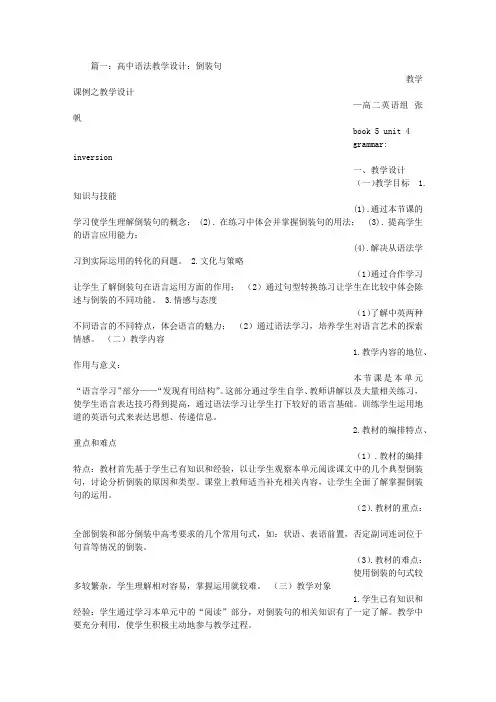
篇一:高中语法教学设计:倒装句教学课例之教学设计—高二英语组张帆book 5 unit 4grammar: inversion一、教学设计(一)教学目标 1.知识与技能(1).通过本节课的学习使学生理解倒装句的概念; (2).在练习中体会并掌握倒装句的用法; (3).提高学生的语言应用能力;(4).解决从语法学习到实际运用的转化的问题。
2.文化与策略(1)通过合作学习让学生了解倒装句在语言运用方面的作用;(2)通过句型转换练习让学生在比较中体会陈述与倒装的不同功能。
3.情感与态度(1)了解中英两种不同语言的不同特点,体会语言的魅力;(2)通过语法学习,培养学生对语言艺术的探索情感。
(二)教学内容1.教学内容的地位、作用与意义:本节课是本单元“语言学习”部分——“发现有用结构”。
这部分通过学生自学、教师讲解以及大量相关练习,使学生语言表达技巧得到提高,通过语法学习让学生打下较好的语言基础。
训练学生运用地道的英语句式来表达思想、传递信息。
2.教材的编排特点、重点和难点(1).教材的编排特点:教材首先基于学生已有知识和经验,以让学生观察本单元阅读课文中的几个典型倒装句,讨论分析倒装的原因和类型。
课堂上教师适当补充相关内容,让学生全面了解掌握倒装句的运用。
(2).教材的重点:全部倒装和部分倒装中高考要求的几个常用句式,如:状语、表语前置,否定副词连词位于句首等情况的倒装。
(3).教材的难点:使用倒装的句式较多较繁杂,学生理解相对容易,掌握运用就较难。
(三)教学对象1.学生已有知识和经验:学生通过学习本单元中的“阅读”部分,对倒装句的相关知识有了一定了解。
教学中要充分利用,使学生积极主动地参与教学过程。
2.学生学习方法和技巧:在现实语法学习过程中,很多学生过分把注意力放在语法规则上面,而不注重语言运用能力的培养。
在教学中,通过句型转换、改错等练习的训练让学生在实际中运用语法规则,而不是死记硬背语法的条条框框。
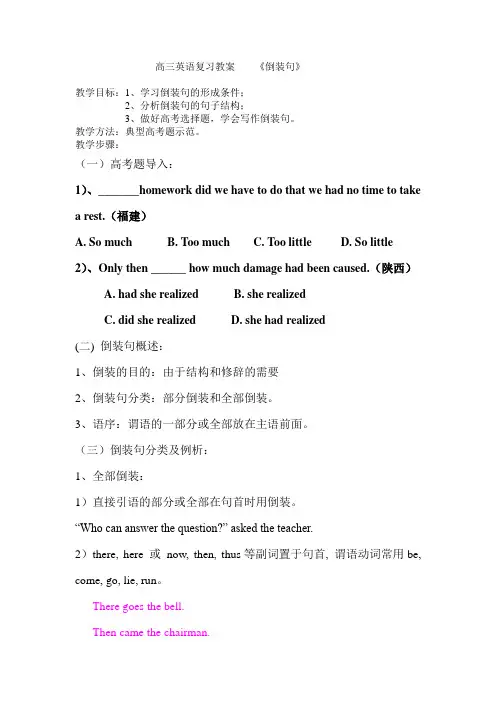
高三英语复习教案《倒装句》教学目标:1、学习倒装句的形成条件;2、分析倒装句的句子结构;3、做好高考选择题,学会写作倒装句。
教学方法:典型高考题示范。
教学步骤:(一)高考题导入:1)、_______homework did we have to do that we had no time to take a rest.(福建)A. So muchB. Too muchC. Too littleD. So little 2)、Only then ______ how much damage had been caused.(陕西)A. had she realizedB. she realizedC. did she realizedD. she had realized(二) 倒装句概述:1、倒装的目的:由于结构和修辞的需要2、倒装句分类:部分倒装和全部倒装。
3、语序:谓语的一部分或全部放在主语前面。
(三)倒装句分类及例析:1、全部倒装:1)直接引语的部分或全部在句首时用倒装。
“Who can answer the question?” asked the teacher.2)there, here 或now, then, thus等副词置于句首, 谓语动词常用be, come, go, lie, run。
There goes the bell.Then came the chairman.Here is your letter.There will be a football match this afternoon.Here comes the busThere goes the bell3)表示方位的副词放句首时用倒装Out rushed the students.Out rushed a missile from under the bomber.Ahead sat an old woman注意:上述全部倒装的句型结构的主语必须是名词,如果主语是人称代词则不能完全倒装。
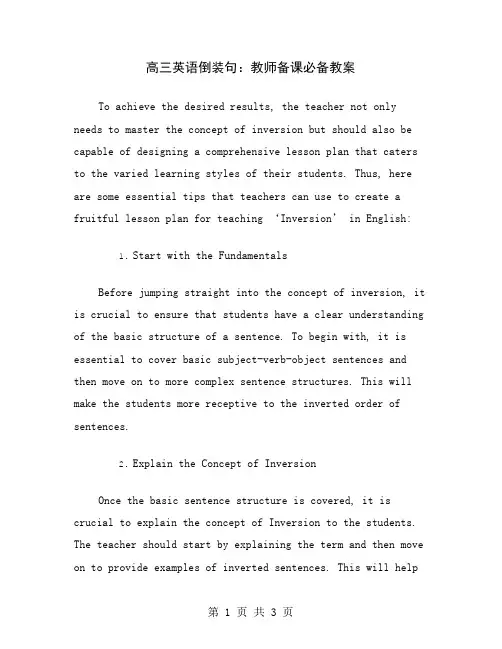
高三英语倒装句:教师备课必备教案To achieve the desired results, the teacher not only needs to master the concept of inversion but should also be capable of designing a comprehensive lesson plan that caters to the varied learning styles of their students. Thus, here are some essential tips that teachers can use to create a fruitful lesson plan for teaching ‘Inversion’ in English:1.Start with the FundamentalsBefore jumping straight into the concept of inversion, it is crucial to ensure that students have a clear understanding of the basic structure of a sentence. To begin with, it is essential to cover basic subject-verb-object sentences and then move on to more complex sentence structures. This will make the students more receptive to the inverted order of sentences.2.Explain the Concept of InversionOnce the basic sentence structure is covered, it is crucial to explain the concept of Inversion to the students. The teacher should start by explaining the term and then move on to provide examples of inverted sentences. This will helpstudents gain a better understanding of the topic and appreciate the usage of inversions in English.3.Demonstrate with ExamplesUsing examples is an essential ingredient in creating an effective lesson plan. The teacher must use simple to complex examples to demonstrate how inversion works. This will help the students learn better and develop a stronger grasp of the concept.4.Encourage PracticeAfter the students have gained a clear understanding of the concept, the teacher must provide ample practice opportunities to encourage the student's participation. It is essential not only to test the students' knowledge but also to foster their ability to incorporate the concept within their writing.5.Revise and ReviewThe teacher should revise the entire lesson plan and ensure that it is well-structured, concise and caters to the learning styles of all the students in the classroom. To ensure that the students have fully understood the concept,the teacher should also conduct regular reviews and assessments.In conclusion, teaching inversion is a daunting task, but with the right lesson plan, teachers can successfully impart this important concept to their students. By following the guidelines mentioned above, teachers can create comprehensive lesson plans that cater to their student's learning styles and help students develop a stronger grasp of the English language.。
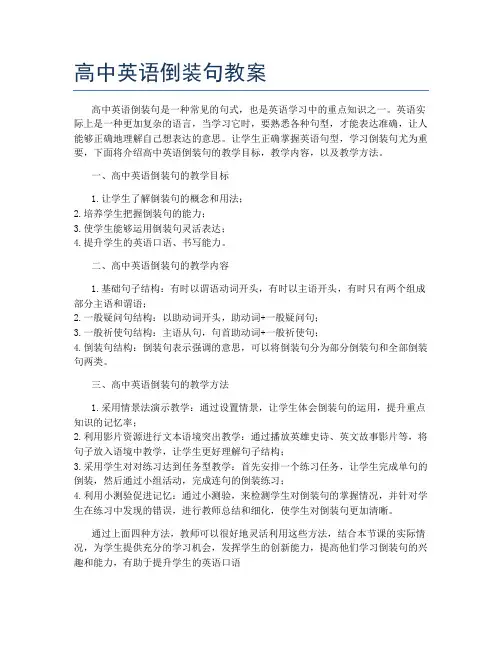
高中英语倒装句教案高中英语倒装句是一种常见的句式,也是英语学习中的重点知识之一。
英语实际上是一种更加复杂的语言,当学习它时,要熟悉各种句型,才能表达准确,让人能够正确地理解自己想表达的意思。
让学生正确掌握英语句型,学习倒装句尤为重要,下面将介绍高中英语倒装句的教学目标,教学内容,以及教学方法。
一、高中英语倒装句的教学目标1.让学生了解倒装句的概念和用法;2.培养学生把握倒装句的能力;3.使学生能够运用倒装句灵活表达;4.提升学生的英语口语、书写能力。
二、高中英语倒装句的教学内容1.基础句子结构:有时以谓语动词开头,有时以主语开头,有时只有两个组成部分主语和谓语;2.一般疑问句结构:以助动词开头,助动词+一般疑问句;3.一般祈使句结构:主语从句,句首助动词+一般祈使句;4.倒装句结构:倒装句表示强调的意思,可以将倒装句分为部分倒装句和全部倒装句两类。
三、高中英语倒装句的教学方法1.采用情景法演示教学:通过设置情景,让学生体会倒装句的运用,提升重点知识的记忆率;2.利用影片资源进行文本语境突出教学:通过播放英雄史诗、英文故事影片等,将句子放入语境中教学,让学生更好理解句子结构;3.采用学生对对练习达到任务型教学:首先安排一个练习任务,让学生完成单句的倒装,然后通过小组活动,完成连句的倒装练习;4.利用小测验促进记忆:通过小测验,来检测学生对倒装句的掌握情况,并针对学生在练习中发现的错误,进行教师总结和细化,使学生对倒装句更加清晰。
通过上面四种方法,教师可以很好地灵活利用这些方法,结合本节课的实际情况,为学生提供充分的学习机会,发挥学生的创新能力,提高他们学习倒装句的兴趣和能力,有助于提升学生的英语口语。

高三英语语法复习教案:倒装句复习教案
【摘要】教案是整个课程的大纲,使得学生更有逻辑的调理的理解其讲
课内容。
高三英语教案栏目小编也特意为您编辑了此文:“高三英语语法复习
教案:倒装句复习教案”祝您浏览愉快。
本文题目:高三英语语法复习教案:倒装句复习教案
【考纲解读】
倒装句是高考的热点。
近年来命题者加大了对句子结构和知识面的考查,
同时注重考查知识之间的交叉和语法知识的力度。
这就要求我们在平时的复
习和备考中注意总结,全面把握,深入研究。
倒装句有以下六大考点:
(1)含有否定意义的副词放在句首引起的部分倒装
(2)含有否定意义的连接词置于句首引起的部分倒装
(3) “so(nor,neither)+助动词+ 主语”与“so(nor,neither)+主语+助动词”之间的区别以及与“ so + 主语+ 助动词”的句式区别
(4)省略if 的虚拟条件句以had / were / should 开头引起的部分倒装。
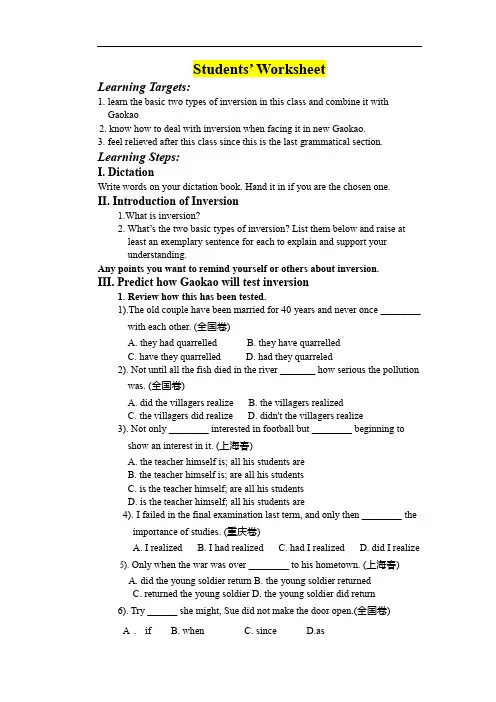
Students’ WorksheetLearning Targets:1. learn the basic two types of inversion in this class and combine it with Gaokao2. know how to deal with inversion when facing it in new Gaokao.3. feel relieved after this class since this is the last grammatical section. Learning Steps:I. DictationWrite words on your dictation book. Hand it in if you are the chosen one.II. Introduction of Inversion1.What is inversion?2. What’s the two basic types of inversion? List them below and raise atleast an exemplary sentence for each to explain and support yourunderstanding.Any points you want to remind yourself or others about inversion.III. Predict how Gaokao will test inversion1. Review how this has been tested.1).The old couple have been married for 40 years and never once ________with each other. (全国卷)A. they had quarrelledB. they have quarrelledC. have they quarrelledD. had they quarreled2). Not until all the fish died in the river _______ how serious the pollutionwas. (全国卷)A. did the villagers realizeB. the villagers realizedC. the villagers did realizeD. didn't the villagers realize3). Not only ________ interested in football but ________ beginning toshow an interest in it. (上海春)A. the teacher himself is; all his students areB. the teacher himself is; are all his studentsC. is the teacher himself; are all his studentsD. is the teacher himself; all his students are4).I failed in the final examination last term, and only then ________ theimportance of studies. (重庆卷)A. I realizedB. I had realizedC. had I realizedD. did I realize5). Only when the war was over ________ to his hometown. (上海春)A. did the young soldier returnB. the young soldier returnedC. returned the young soldierD. the young soldier did return6). Try ______ she might, Sue did not make the door open.(全国卷)A.if B. when C. since D.as7). Translate the sentence in boldface.They are among the growing number of Americans who,driven by higher living costs and a failing economy,have taken up vegetable gardening for the first time.Others have increased the size of their existing gardens.Seed companies and garden shops say that not since the1970s has there been such an increase in interest in growingfood at home.Now many gardens across the country have been sold out for several months.In Austin,Tex.,so me of the gardens have a three-year waiting list.(全国卷)8). Not once ________ it occur to Michael that he could one day become atop student in his class.(扶栏卷)9). Not until he went through real hardship ________ he realize the love wehave for our families is important.(胡建卷)10). Correction:(Just find out the inversion mistake.)Recent, every morning and evening, many people gather to dance in our community square, which do help to keep healthy. However, the long-time dancing and the noise pollution causing by the loudspeaker really bring about unbearable inconveniences.We can’t rest or sleep well. As a result of, the students are not only later for school but also sleepy in class, and the workers are easily tired out before working. Here are some suggestions to solve the problem. They are supposed either to shorten the dancing time and reduce the music noise nor to make another choice of dancing places. Only in this way they have fun and let others enjoy life.2.Analyse the test types of GaokaoReading comprehension:Cloze:Filling in the blanks:Correction:Writing:3. Can you make any prediction about inversion in Gaokao?IV. Pracitce:1). Only when he apologizes for his rudeness________ I speak to him again.2). No sooner _______ Mo Yan stepped on the stage than the audience brokeinto thunderous applause. (陕西卷)3). At the foot of the mountain _______.A. a village lieB. lies a villageC. does a village lieD. lying a village4). What would have happened________, as far as the river bank?A. Bob had walked fartherB. if Bob should walk fartherC. had Bob walked fartherD. if Bob walked farther5). In the dark forests ________, some large enough to hold several Englishtowns.A. stand many lakesB. lie many lakes C.many lakes lie D.many lakesstand6). Mark the sentence(s) using inversion and translate it/them.Perhaps you think you could easily add to your happiness with more money.Strange as it may seem, if you’re not satisfied, the issue is not a lack ofmeans to meet your desire but a lack of desire-not that you can satisfy yourtastes but that you don’t have enough tastes.7). Correction:My uncle is a doctor. One day, a very tiring man went to him and said,“Doctor, dogs in my neighborhood bark all night and I can’t get somesleep.”“Well, here is some sleeping pills that work really well. Taken a fewof these, and you’ll feel better.” My uncle said.“Great,” the man replies.“Thank you” A few weeks later, the man returned. He looked like worse thanever. “Doctor, my plan is useless. I’m much tired than before.”“I don’tunderstand,” said my uncle. “Those are the strongest pills on market.”“Thatmay be true,” the man said. “and I spent all night running after those dogs.When I finally caught one, he wouldn’t swallow the pill.”8).这里有一些帮你释放压力的建议。
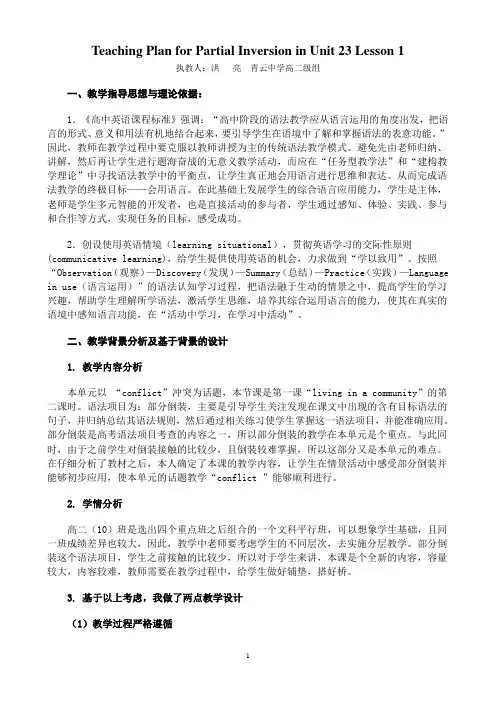
Teaching Plan for Partial Inversion in Unit 23 Lesson 1执教人:洪亮青云中学高二级组一、教学指导思想与理论依据:1.《高中英语课程标准》强调:“高中阶段的语法教学应从语言运用的角度出发,把语言的形式、意义和用法有机地结合起来,要引导学生在语境中了解和掌握语法的表意功能。
”因此,教师在教学过程中要克服以教师讲授为主的传统语法教学模式。
避免先由老师归纳、讲解,然后再让学生进行题海奋战的无意义教学活动,而应在“任务型教学法”和“建构教学理论”中寻找语法教学中的平衡点,让学生真正地会用语言进行思维和表达。
从而完成语法教学的终极目标——会用语言。
在此基础上发展学生的综合语言应用能力,学生是主体,老师是学生多元智能的开发者,也是直接活动的参与者,学生通过感知、体验、实践、参与和合作等方式,实现任务的目标,感受成功。
2.创设使用英语情境(learning situational),贯彻英语学习的交际性原则(communicative learning),给学生提供使用英语的机会,力求做到“学以致用”。
按照“Observation(观察)—Discovery(发现)—Summary(总结)—Practice(实践)—Language in use(语言运用)”的语法认知学习过程,把语法融于生动的情景之中,提高学生的学习兴趣,帮助学生理解所学语法,激活学生思维,培养其综合运用语言的能力, 使其在真实的语境中感知语言功能,在“活动中学习,在学习中活动”。
二、教学背景分析及基于背景的设计1. 教学内容分析本单元以“conflict”冲突为话题,本节课是第一课“living in a community”的第二课时。
语法项目为:部分倒装,主要是引导学生关注发现在课文中出现的含有目标语法的句子,并归纳总结其语法规则,然后通过相关练习使学生掌握这一语法项目,并能准确应用。
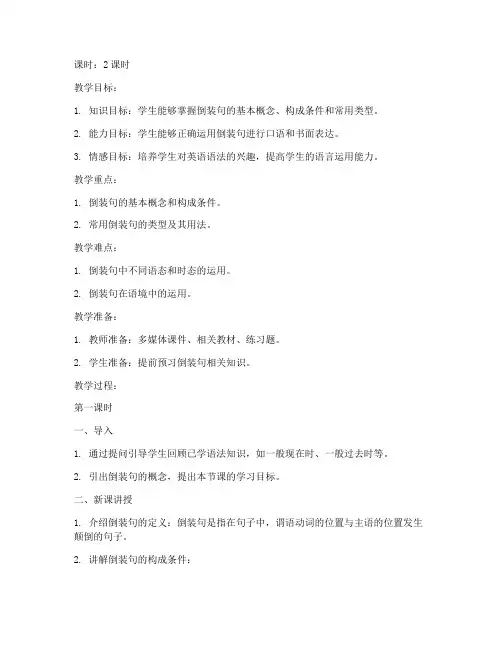
课时:2课时教学目标:1. 知识目标:学生能够掌握倒装句的基本概念、构成条件和常用类型。
2. 能力目标:学生能够正确运用倒装句进行口语和书面表达。
3. 情感目标:培养学生对英语语法的兴趣,提高学生的语言运用能力。
教学重点:1. 倒装句的基本概念和构成条件。
2. 常用倒装句的类型及其用法。
教学难点:1. 倒装句中不同语态和时态的运用。
2. 倒装句在语境中的运用。
教学准备:1. 教师准备:多媒体课件、相关教材、练习题。
2. 学生准备:提前预习倒装句相关知识。
教学过程:第一课时一、导入1. 通过提问引导学生回顾已学语法知识,如一般现在时、一般过去时等。
2. 引出倒装句的概念,提出本节课的学习目标。
二、新课讲授1. 介绍倒装句的定义:倒装句是指在句子中,谓语动词的位置与主语的位置发生颠倒的句子。
2. 讲解倒装句的构成条件:a. 句首有否定副词或否定词组,如never, hardly, seldom, little, not only...but also...等。
b. 句首有疑问词,如who, what, when, where, why, how等。
c. 句首有表示地点的介词短语,如in the front, on the top等。
3. 举例说明倒装句的类型及其用法:a. 疑问句倒装:如“Where did you go yesterday?”b. 否定句倒装:如“Never have I seen such a beautiful scene before.”c. 条件句倒装:如“If I had known, I would have helped you.”d. 让步状语从句倒装:如“Though he is poor, he is honest.”三、课堂练习1. 完成教材中的练习题,巩固所学知识。
2. 教师讲解练习题,纠正学生错误。
四、总结1. 总结本节课所学内容,强调倒装句的基本概念、构成条件和常用类型。
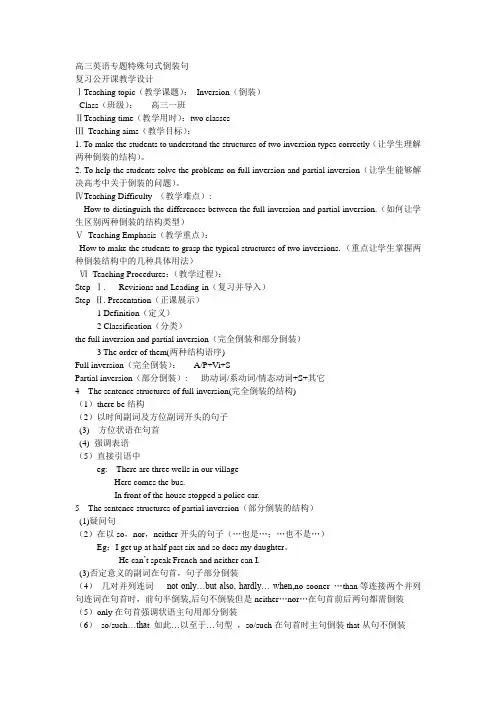
高三英语专题特殊句式倒装句复习公开课教学设计ⅠTeaching topic(教学课题):Inversion(倒装)Class(班级):高三一班ⅡTeaching time(教学用时):two classesⅢTeaching aims(教学目标):1. To make the students to understand the structures of two inversion types correctly(让学生理解两种倒装的结构)。
2. To help the students solve the problems on full inversion and partial inversion(让学生能够解决高考中关于倒装的问题)。
ⅣTeaching Difficulty (教学难点):How to distinguish the differences between the full inversion and partial inversion.(如何让学生区别两种倒装的结构类型)ⅤTeaching Emphasis(教学重点):How to make the students to grasp the typical structures of two inversions. (重点让学生掌握两种倒装结构中的几种具体用法)ⅥTeaching Procedures:(教学过程):Step Ⅰ. Revisions and Leading-in(复习并导入)Step Ⅱ. Presentation(正课展示)1 Definition(定义)2 Classification(分类)the full inversion and partial inversion(完全倒装和部分倒装)3 The order of them(两种结构语序)Full inversion(完全倒装):A/P+Vi+SPartial inversion(部分倒装): 助动词/系动词/情态动词+S+其它4 The sentence structures of full inversion(完全倒装的结构)(1)there be结构(2)以时间副词及方位副词开头的句子(3) 方位状语在句首(4) 强调表语(5)直接引语中eg: There are three wells in our villageHere comes the bus.In front of the house stopped a police car.5 The sentence structures of partial inversion(部分倒装的结构)(1)疑问句(2)在以so,nor,neither开头的句子(…也是…;…也不是…)Eg:I get up at half past six and so does my daughter。
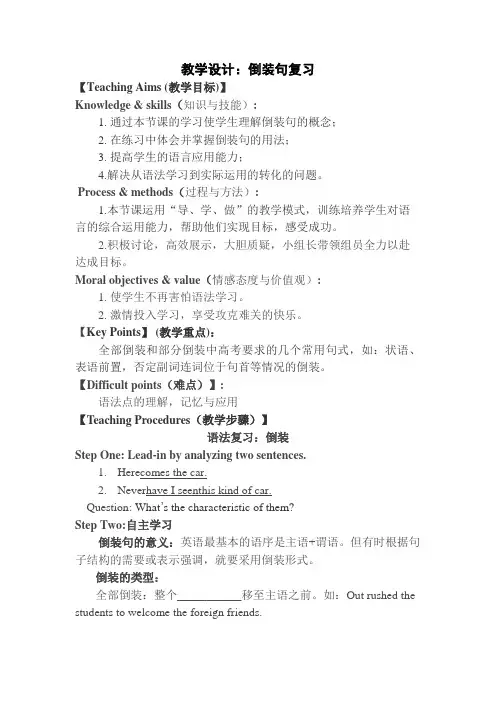
教学设计:倒装句复习【Teaching Aims (教学目标)】Knowledge & skills(知识与技能):1. 通过本节课的学习使学生理解倒装句的概念;2. 在练习中体会并掌握倒装句的用法;3. 提高学生的语言应用能力;4.解决从语法学习到实际运用的转化的问题。
Process & methods(过程与方法):1.本节课运用“导、学、做”的教学模式,训练培养学生对语言的综合运用能力,帮助他们实现目标,感受成功。
2.积极讨论,高效展示,大胆质疑,小组长带领组员全力以赴达成目标。
Moral objectives & value(情感态度与价值观):1. 使学生不再害怕语法学习。
2. 激情投入学习,享受攻克难关的快乐。
【Key Points】 (教学重点):全部倒装和部分倒装中高考要求的几个常用句式,如:状语、表语前置,否定副词连词位于句首等情况的倒装。
【Difficult points(难点)】:语法点的理解,记忆与应用【Teaching Procedures(教学步骤)】语法复习:倒装Step One: Lead-in by analyzing two sentences.1.Herecomes the car.2.Neverhave I seenthis kind of car.Question: What’s the characteristic of them?Step Two:自主学习倒装句的意义:英语最基本的语序是主语+谓语。
但有时根据句子结构的需要或表示强调,就要采用倒装形式。
倒装的类型:全部倒装:整个___________移至主语之前。
如:Out rushed the students to welcome the foreign friends.部分倒装:只把_______________________________________放在主语之前。
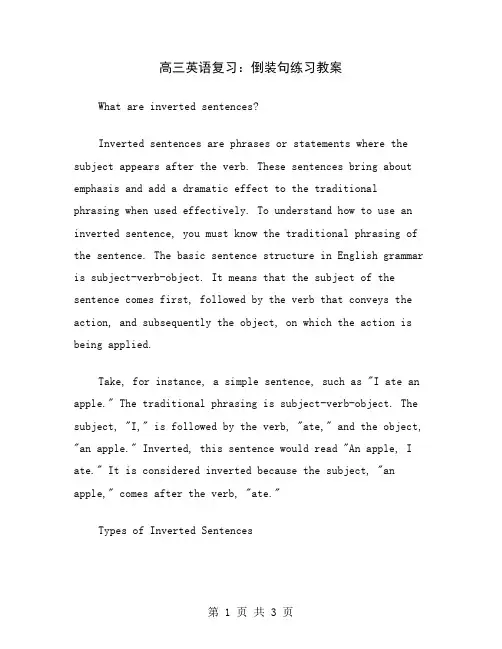
高三英语复习:倒装句练习教案What are inverted sentences?Inverted sentences are phrases or statements where the subject appears after the verb. These sentences bring about emphasis and add a dramatic effect to the traditional phrasing when used effectively. To understand how to use an inverted sentence, you must know the traditional phrasing of the sentence. The basic sentence structure in English grammar is subject-verb-object. It means that the subject of the sentence comes first, followed by the verb that conveys the action, and subsequently the object, on which the action is being applied.Take, for instance, a simple sentence, such as "I ate an apple." The traditional phrasing is subject-verb-object. The subject, "I," is followed by the verb, "ate," and the object, "an apple." Inverted, this sentence would read "An apple, I ate." It is considered inverted because the subject, "an apple," comes after the verb, "ate."Types of Inverted SentencesThere are different types of inverted sentences, each with its own unique function. We'll go through some examples below.1.Negative InversionNegative inversion is used for emphasis, and it's formed by placing 'not' before the auxiliary verb, and the subject after the auxiliary verb. The structure is not + auxiliary verb + subject (inverted verb).Example: "Never have I seen such a beautiful sight."2.Conditional InversionConditional inversion revolves around the use of "if" and is often utilized in hypothetical situations. The sentence structure in inverted conditional sentences is inverted subject + auxiliary verb + subject. Conditional inversion is considered to be formal and therefore restrained to use in formal communication.Example: "Had I known earlier, I would have bought the book."3.Question InvertIn a question invert, the subject and verb are inverted while forming a question. One example of question invert is; (verb) + (subject), in place of (subject) + (verb) structure while asking a question. In question invert, an inverted comma acts as a signifier that the sentence is interrogative.Example: "Are you happy?" can also be written as "You are happy, aren’t you?"Inverted sentences have many uses in the English language. They are useful when a writer wants to emphasize ideas and meanings, create a poetic flow, encourage engagement and thought, and build suspense. It's a useful tool to have inyour writing arsenal if you want to take your writing to the next level.。
高考英语语法复习教案-倒装句和省略句教学目标:1. 理解倒装句的定义和分类;2. 掌握倒装句的用法和注意事项;3. 理解省略句的定义和分类;4. 掌握省略句的用法和注意事项;5. 能够正确运用倒装句和省略句进行口语和书面表达。
教学内容:第一章:倒装句概述1.1 倒装句的定义1.2 倒装句的分类1.3 倒装句的用法和注意事项第二章:完全倒装句2.1 完全倒装句的定义和用法2.2 完全倒装句的注意事项第三章:部分倒装句3.1 部分倒装句的定义和用法3.2 部分倒装句的注意事项第四章:倒装句与其他句式的结合4.1 倒装句与疑问句的结合4.2 倒装句与条件句的结合4.3 倒装句与虚拟语气的结合第五章:省略句概述5.1 省略句的定义5.2 省略句的分类5.3 省略句的用法和注意事项教学方法:1. 采用讲授法,讲解倒装句和省略句的定义、分类、用法和注意事项;2. 通过例句和练习,让学生熟练掌握倒装句和省略句的运用;3. 采用互动式教学,鼓励学生提问和参与讨论,提高学生的积极性和理解能力;4. 布置适量的练习题,巩固所学知识,提高学生的应用能力。
教学评估:1. 课堂参与度:观察学生在课堂上的发言和提问情况,评估学生的积极参与程度;2. 练习完成情况:检查学生完成练习题的情况,评估学生对倒装句和省略句的掌握程度;3. 课后作业:布置相关的课后作业,评估学生对课堂所学知识的巩固程度。
教学资源:1. 教学PPT:制作精美的教学PPT,展示倒装句和省略句的定义、分类、用法和注意事项;2. 例句和练习题:提供丰富的例句和练习题,帮助学生理解和巩固倒装句和省略句的知识;3. 参考资料:提供相关的参考资料,供学生自主学习和拓展知识。
教学进度安排:1. 第一章:2课时2. 第二章:2课时3. 第三章:2课时4. 第四章:2课时5. 第五章:2课时教学总结:通过本章的教学,学生应该能够理解倒装句和省略句的定义和分类,掌握倒装句和省略句的用法和注意事项,并能够正确运用倒装句和省略句进行口语和书面表达。
倒装句复习教学设计一、教学目标1.引导学生复习巩固倒装句的意义及其分类;2.引导学生复习巩固倒装句的基本用法并掌握不用倒装的几种情况;3.通过典型中考题型,引导学生掌握倒装句的实际应用,使学生养成良好的分析题目和解析题目的习惯和能力。
二、教学重、难点1.完全倒装和部分倒装的区别及不用倒装的几种情况;2.倒装句在题目中的实际应用。
三、教学设计1.倒装句的意义和分类(1).倒装句的意义:英语句子的基本语序是比较固定的,一般主语在前,谓语在后。
但有时因为语法结构的要求或由于修辞的要求,往往要改变句子的自然语序,把一些本应置于主语之后的成分提前,我们称这种语序为倒装语序。
(2).倒装句的分类:倒装语序又分为全部(完全)倒装和部分倒装。
2.全部(完全)倒装如果谓语动词全部放在主语之前,这种语序称为完全倒装。
(1).表示方位的副词out,up,down,in,away置于句首时,句子要全部倒装。
eg. Out rushed the children. 孩子们冲了出去。
注:一般情况下,当主语是人称代词时,句子的语序不倒装。
eg. Away he went.他走开了。
(2).表示方位的介词短语置于句首时,句子要全部倒装。
eg. In front of the school is the hospital. 学校的前面就是医院。
注:介词短语在倒装句中要整体前移,不能拆开(3).在以here,there等副词开头的句子里,要用全部倒装以示强调。
eg. Here comes the bus.公共汽车来了。
注:以here,there等引导的句子中,谓语动词常为be,come,go等,且时态为一般现在时,如果主语是人称代词则不用倒装。
eg. Here they are. 它们在这儿。
(4).以表示时间的副词now,then引导的句子,谓语动词是come,begin,end,follow,be等时,句子用全部倒装。
eg. Then came the workers.接着来的是工人。
教你如何更好地掌握倒装句:高三英语复习教案。
一、什么是倒装句倒装句是指在句子中将某个成分的顺序颠倒过来,使得主语不在句子的开头,并且要注意助动词的使用和位置。
根据倒装句的形式和作用,可以分为全部倒装和部分倒装两种类型。
1.全部倒装句完全倒装句的句式为:助动词/系动词/情态动词+主语+谓语+其他例如:Hardly had I arrived at the airport when the plane took off.Never again will I make that mistake.Seldom does he go to the cinema.Not only does she teach English, but she also writes novels.在这些例子中,我们可以发现,主语的位置通常在谓语之后,这就是所谓的完全倒装句。
通常使用于句子的倒装中,包括一些副词,如hardly, never, seldom以及Not only… but also等。
2.部分倒装句部分倒装句是指只将句子中的某一部分倒置,其他成分则保持原来的顺序。
它通常用来强调句子中的某个成分,或者在条件句、疑问句、感叹句和祈使句中使用。
例如:Only in this way can we solve the problem.We seldom see such a beautiful sunshine.This way of life is what I am longing for.If he comes, I will go.Had he known the truth, he would not have done that.Not until he came did I realize how much I missed him.On no account should you give up halfway.As soon as he saw me, he ran away.二、如何更好地掌握倒装句1.深入理解语法规则和用法我们需要掌握倒装句的语法规则和用法,弄清楚哪些词语和语境下需要使用倒装句,哪些不需要。
高三英语倒装句型复习新寨高中杨文娟一、教材内容分析:倒装句是高中英语重要的语法之一,也是近年来高考的热点,它出现在高考的各个题型中,既是重点,也是难点。
因此让学生全面握掌握和熟练运用该语法是非常重要的。
为此,我确立了以下教学目标:1.知识目标:熟悉和掌握倒装句的各种类型。
2.能力目标:能够运用倒装句的类型结构做题。
3.情感目标:教育学生爱学习,爱健康。
二、学生情况分析:本届学生基础不够扎实,对学过的语法缺乏全面的了解和掌握。
针对教学内容和学生实际情况,我确立了以下教学重难点:1.教学重点:倒装的各种句型。
2. 教学难点:倒装句类型的区分和运用。
三、教学方法:为了突出重点,突破难点,我在本节课主要本着由浅入深,循序渐进教学原则,让学生在复习中巩固,在巩固中提高。
以多媒体课件贯穿始终。
以师生个体、群体互动;学生分组竞赛;学生小组讨论等形式完成三层练习:基础巩固题---能力提高题----高考真题。
并将本节课所授内容的要点纲要打印分发便于学生针对自己的实际情况整理笔记和记忆。
四、教学过程:模块一:倒装的定义和分类(此处通过师生问答的方式强化倒装类型活跃课堂气氛)定义:将全部谓语或谓语的一部分放在主语之前的句子,叫做倒装句。
分类:完全倒装、部分倒装和形式倒装类型判断:Gone are the days when we were children.Little did they say about the accident.Cold as it was, we went out. 模块二:完全倒装(通过填空和选择的练习让学生自己总结出此类倒装的特点培养学生自己发现问题和解决问题的能力)1. there be 句型2.副词+谓+主()3.(介短/分词/代词)+谓+主要点强调:(针对考点强化解题重点难点是学生印象深刻)1. 副词放在句首时,主语是人称代词时不用完全倒装.2.完全倒装不用进行时态基础巩固练习:(见附页)(设置6道难度较小的单选题型让学生进一步巩固句型特点和解题要点,为复习部分倒装做准备。
高中英语《倒装句》复习教案高中英语《倒装句》复习教案I.Pre-learning试体会下列两种句子说表达的情感的不同点。
NO.1The teacher came in.老师进来了。
In came the teacher.进来了个老师。
(语气具有不确定性,不知道进来的是哪个老师。
NO.2 Carl said:"I love my motherland more than myself!"Carl说:“我爱我的祖国胜过爱我自己!”"I love my motherland more than myself!"said Carl.“我爱我的祖国胜过爱我自己!”Carl说道。
(小说里面经常这样用!由于语法、修辞或者情感表达的需要,而将谓语或者谓语的一部分提到主语前面,从而构成倒装II.完全倒装----谓语部分全部出现在主语前V+S+OA.状语置于句首引起完全倒装B.分词置于句首引起完全倒装C.there be句型的完全倒装1.状语置于句首Structure:Adv+V+SIn the middle of Tiananmen Square stands the monument to the people's heroes.人民英雄纪念碑矗立在天安门广场正中央。
By the side of him sits a faithful dog.小练习:1._____and caught the mouse.A.Up the cat jumpedB.The cat up jumpedC.Up jumped the catD.Jumped up the cat2.那男孩从自行车上摔下来了!the boy from his bike.3.John opened the door,there he had never seen before.A.a girl did standB.a girl stoodC.stood a girl⊙如果主语是代词(pronj,主语和谓语的语序就不需要变换,只需提前状语。
高中英语词法专题倒装句精品教案一、教学目标•了解倒装句在句子结构中的作用和表达方式。
•掌握倒装句的基本用法。
•能够灵活运用倒装句来提高语言表达能力。
二、教学重点•理解倒装句的概念和作用。
•掌握倒装句的常见形式和运用场景。
三、教学准备•教师准备教学课件和教材。
•学生准备纸笔,做笔记。
四、教学过程1. 引入(教师利用幻灯片或黑板白板进行教学)倒装句是英语语法中的一种重要结构,它的使用能够提高句子的表达效果,使语言更加生动有力。
在句子中常常采用主谓倒装和完全倒装两种形式。
那么,我们首先来了解一下什么是倒装句,以及它在句子中的作用。
2. 知识讲解1.主谓倒装主谓倒装是指将句子中的主语和谓语的位置进行调换,从而使句子结构颠倒的一种表达方式。
主谓倒装常出现在以下情况:•在句首表示强调或突出某一部分内容,常用于频度副词、时间状语等的引导下。
例如:–Never have I seen such a beautiful sunset.–Not only does he study hard, but he also plays basketball well.•在虚拟条件句和否定词连用时,常用于if引导的条件句中。
例如:–Had he known the truth, he wouldn’t have made that mistake.–Should you have any questions, please feel free to ask.2.完全倒装完全倒装是指将整个谓语放在主语之前的一种倒装结构。
完全倒装常出现在以下情况:•在以副词here, there, out, up等开头的句子中。
例如:–Here comes the bus.–Down fell the rain.•在以“so + 形容词/副词 + 主语”结构的句子中。
例如:–So fast did he run that he won the race.3.判断倒装句如何判断一个句子是否为倒装句呢?主谓倒装和完全倒装句的主要特点是谓语放在主语之前,除此之外还要注意以下几点:•主谓倒装句中,主语和谓语之间是否有不可分割的词,如never, seldom, by no means等。
高中英语《倒装句》复习教案I.Pre-learning试体会下列两种句子说表达的情感的不同点。
NO.1The teacher came in.老师进来了。
In came the teacher.进来了个老师。
(语气具有不确定性,不知道进来的是哪个老师。
NO.2 Carl said:"I love my motherland more than myself!"Carl说:“我爱我的祖国胜过爱我自己!”"I love my motherland more than myself!"said Carl.“我爱我的祖国胜过爱我自己!”Carl说道。
(小说里面经常这样用!由于语法、修辞或者情感表达的需要,而将谓语或者谓语的一部分提到主语前面,从而构成倒装II.完全倒装----谓语部分全部出现在主语前V+S+OA.状语置于句首引起完全倒装B.分词置于句首引起完全倒装C.there be句型的完全倒装1.状语置于句首Structure:Adv+V+SIn the middle of Tiananmen Square stands the monument to the people's heroes.人民英雄纪念碑矗立在天安门广场正中央。
By the side of him sits a faithful dog.小练习:1._____and caught the mouse.A.Up the cat jumpedB.The cat up jumpedC.Up jumped the catD.Jumped up the cat2.那男孩从自行车上摔下来了!the boy from his bike.3.John opened the door,there he had never seen before.A.a girl did standB.a girl stoodC.stood a girl⊙如果主语是代词(pronj,主语和谓语的语序就不需要变换,只需提前状语。
Here they come!他们来了!Here comes the bus!公交车来了!小练习:1.look,_____.A.there goes heB.he there goesC.there he goesD.he goes there2.Clark去那里!⊙Watch Out!以here,there,now,then,in,out,up,down,off,away等副词开头的句子,可将谓语动词放在主语之前,引起倒装Now comes your turn.该你了。
Then followed three days of heavy rain.接下来三天都在下大雨。
Out rushed the students from the classroom.学生们从教室里蜂拥出去。
Away went the boss.老板走了。
想一想:“他从自行车上摔下来了”这句话该怎么翻译?He fell off from his bike.若换成倒装句呢?还是这样么?Off he fell from his bike.(如果主语是代词(pronj,主语和谓语的语序就不需要变换,只需提前状语Exercise:1.Out there,in the midst of the snow,in long,black clothes.A.a woman satB.sat a womanC.sitting a woman wasD.a woman was sitting2.At the meeting place of the Y angtze River and the Jialing River,one of the ten large st city in China.A.lies ChongqingB.Chongqing liesC.does lie ChongqingD.does Chongqing lie3.茂密的森林中有很多湖,一些湖大得可以容纳几个英国城镇。
In the dark forests lie many lakes,some large enough to hold several English towns.(在描述情景时,为了使情景更生动形象,有时把状语部分放在句首表示强调,同时句子用倒装2.分词置于句首为了强调,在进行时态中,有时候可将现在分词置于句首,在被动语态中,可将过去分词置于句首,从而构成完全倒装。
Standing among the students was the well-known singer.Enclosed in the letter is a picture of mine taken in Beijing.3.There be句型中的完全倒装There is little water in the glass.玻璃杯里面没有水了。
There happened to be a taxi parked at the gate.碰巧门口停着一辆的士。
There used to be a lot of trees on the hill.山上过去有很多树。
注意:作地点状语的介词短语位于句首,there省略On the top of the hill stood an old temple.There is an old temple stood on the top of the hill.In front of my haouse is a beautiful garden.There is a beautifu garden in front of my house.完全倒装综合练习1.—Where is Kate?—Look,she is at the school gate.A.there she isB.there is sheC.here you areD.here she is2.a letter for you.A.here isB.is hereC.here did beD.here being3.from the hill.A.Down ran the studentsB.Ran down the studentsC.Down runs the studentsD.The students runs down4.后来连着下了三天大雨。
Then followed three days of heavy rains. III.部分倒装----部分谓语出现在主语前面,句子其它部分不变1.这些句子都是什么意思呢?Little did he know about her.Hardly had I got home when it began to rain.Never had a person escaped from the Skull Island which existed in the mist lively.2.表示祝愿的祈使句Structure:May+S+V+OMay you succeed!祝你成功Long live the People's Republic of China!中华人民共和国万岁!May you return safe and sound!祝你平安归来!3.直接引语的部分倒装(主语是代词时,往往不进行倒装结构Structure:Sentence+V+S“Plato is dear to me,but dearer s till is truth!"said Aristotle."Oh,yes,this is my book."said Tom."Let's go!"suggested Mary."Whom are you looking for"she suggested.4.否定意义的词汇置于句首部分倒装Never before have I met him.我以前从未见过他。
Seldom do I read such magazines.我几乎没有读过这份杂志。
Not until my mom returned home did it I go to bed last night.昨晚直到我妈回家,我才睡觉。
Little does he know what may happen.⊙Watch Out!以never,hardly,scarcely,rarely,barely,seldom,not only,not until,nor,little,nowhere,hardly...whe n,no sooner...than,by no means,under no circumstances等否定或半否定词(组开头的句子,可引起倒装⊙For example1.Not only should we not be afraid of difficulties,but(also we should try our best to ov ercome them.我们不但应该不怕困难,而且要尽自己最大努力去克服它们。
2.By no means will this metod produce satisfactory results.这种方法绝不会产生令人满意的效果。
3.No sooner had he left home than it began to rain.他刚离开家,天就开始下雨了。
4.哪里也找不到那只狗狗。
Nowhere were the dog to be found.5.Rarely true friendship there.A.a person will findB.won't a person findC.a person findsD.does a person find5.So,neither,nor,as置于句首以so开头,表示“也一样”“也这样”的句子要倒装。
1.He is a student,and so am I.他是个学生,我也是。
2.Society has changed and so have the people in it.社会变了,社会上的人也变了。
3.—I'm very interested in French.—So am I.—我对法语很感兴趣。
—我也是。
Structure:So+be/do/have/can或者其它情态动词+S翻译练习1.他现在能游泳了,我也能。